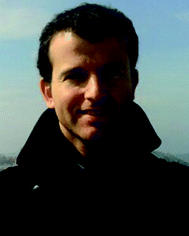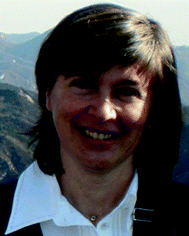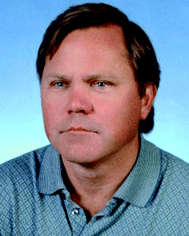Elemental imaging
J. Pisonero*a, N. Bordela and V. S. Smentkowskib
aDepartment of Physics, c/Gonzalo Gutierrez Quiros, Campus de Mieres, University of Oviedo, 33600 Mieres, Spain. E-mail: pisonerojorge@uniovi.es
bGeneral Electric Global Research Center, Niskayuna, NY 12309, USA
 J. Pisonero | Jorge Pisonero is an Associate Professor of Physics (2012) at the University of Oviedo (Spain), from which he obtained his PhD (2004) degree working on glow discharge spectroscopy. After his PhD, he was awarded a 2-year Marie Curie Intra-European Fellowship for a postdoctoral stay at ETH (Switzerland) to work on laser ablation-based techniques. Afterwards, Jorge obtained the prestigious 5-year “Ramon and Cajal” research contract and went back to the University of Oviedo, where in collaboration with Dr Nerea Bordel he established the Laser and Plasma Spectroscopy Research Group (http://www.unioviedo.es/gelp). His current research interests are focused on fundamentals and applications of LIBS, LA-ICP-MS, and atmospheric and low pressure GD spectroscopies. |
 N. Bordel | Nerea Bordel is an Associate Professor of physics at the University of Oviedo (Asturias, Spain). She started her research activity in the laboratory of Atomic Physics and Lasers at the Ciemat (Research Centre for Energy, Environment and Technology) obtaining her PhD degree at the University Complutense of Madrid in 1992. Afterwards her research field has been focused on fundamentals, developments and applications in low pressure glow discharges techniques (with detection by both optical emission and mass spectrometry). At present, her research interests are also extended to developments in atmospheric glow discharges, laser ablation techniques and differential mobility analysis. |
 V. S. Smentkowski | Vincent S. Smentkowski is a Senior Scientist in the Nanostructures and Surfaces Laboratory at General Electric Global Research (GEGR) where he performs surface analysis to support research programs at GEGR, GE businesses, and strategic partners. Currently, his research is focused on the applications of ToF-SIMS analysis, emphasizing how multivariate statistical analysis tools facilitate data reduction. Vin obtained a B.S. degree in chemistry from Marshall University in 1987 and a PhD in physical chemistry (1994) from the University of Pittsburgh, under the guidance of Professor John T. Yates, Jr. After completing his degree, Vin accepted a post-doctoral position at Argonne National Laboratory. |
Dear Readers,
On behalf of the Editorial Board and ourselves, we are really pleased to introduce you to this themed issue on “Elemental Imaging”, which includes a collection of eight papers devoted to elemental imaging using different analytical techniques, including Laser Ablation Inductively Couple Plasma Mass Spectrometry (LA-ICP-MS), Scanning Electron Microscopy-Energy Dispersive X-ray Spectrometry (SEM-EDS), Pulsed Glow Discharge Optical Emission Spectroscopy (pulsed-GD-OES), and Synchrotron-based chemical imaging. Other techniques, which are not included in this issue but are capable of providing elemental imaging information regarding solid samples, include EPMA (Electron Microprobe Analysis, also referred to as “microprobe”), Auger Electron Spectroscopy (AES), X-ray Photoelectron Spectroscopy (XPS), Secondary Ion Mass Spectroscopy (SIMS), and Low Energy Ion Scattering (LEIS). The latter four are considered “near-surface” analytical techniques as they mainly provide information from the first atomic layers unless the sample is eroded to reach sub-surface regions. Time of flight (ToF-)SIMS has proven to be a very powerful technique as it generates a full mass spectrum at every voxel, allowing for the identification of unexpected species. Moreover, this technique provides high (ppm to ppb) sensitivity, high lateral resolution (10's of nm), sub nm depth resolution (for depth profile measurements) and the capability to collect images at every depth, enabling 3D renderings of the data.
• LA-ICP-MS has been developed for the acquisition of elemental and isotopic images from a wide variety of samples, going from biological tissues to geological materials. This technique offers relatively rapid throughput at micro-scale spatial resolution and very wide dynamic range, allowing the determination of major, minor and trace elements. Nevertheless, the fundamental aspects of elemental image acquisition using LA-ICP-MS need to be further investigated to improve the capabilities of this technique. In particular, ablation cell designs must be optimized to promote rapid wash-out times, avoiding cross-contamination of the laser-induced aerosol when rastering the laser at a certain speed along a sample surface. Furthermore, experimental parameters must be carefully evaluated to avoid the blurring effects of re-sampling phenomena, and additional studies are required on the development of appropriate data processing software to produce valuable images.
Elemental imaging of trace elements in biogenic and inorganic carbonates (e.g., Foraminifera) is employed by Evans and Müller1 to obtain valuable palaeoenvironmental information. In this manuscript analytical considerations are presented to improve the quality of images acquired from discontinuous samples, including the use of signal smoothing devices, and the pre-acquisition ablation cleaning. Moreover, O. Reifschneider et al.,2 have highlighted the potential of LA-ICP-MS to perform elemental bio-imaging. In particular, the distribution of the histological stains haematoxylin and eosin (H & E-staining) was elucidated on different tissues, such as appendix, lymph node, fallopian tube and esophageal tumor, by determining the distribution of the aluminum and bromine contained in the stain structure.
Multi-elemental 3D LA-ICP-MS mapping procedure to investigate surface layer phenomena, such as degradation mechanisms of medieval weathered glass, is the subject of the paper by J. T. Elteren et al.3 Each point of the target surface is drilled using a burst of 50 laser pulses at a frequency of 1 Hz, allowing an adequate aerosol evacuation among each laser pulse. This fact combined with the fast ion signal monitoring in the ICP-MS results in spatial elemental data only associated with individual pulses. Therefore, depth resolution is related to the penetration rate per pulse (about 150 nm in glass), while spatial resolution is related to the laser spot diameter (80 μm). Final data manipulation allows the visualization of volume images or time-lapse movies.
LA-ICP-MS has been also applied for elemental imaging of impact spherules, which are spheroidal particles produced by melting, vaporization and condensation of silicate materials when a large extraterrestrial object strikes Earth at cosmic velocity. In particular, 2D mapping of element distribution in a late archean impact spherule layer was obtained by F. Vanhaecke et al.4
Isotopic imaging of biological tissues is the topic of paper by M. R. Florez et al.,5 where the possibilities of LA-single collector-ICP-mass spectrometry are investigated for obtaining isotope ratio images with high spatial resolution (e.g., 30 micrometers) of thin sections of Daphnia magna specimens exposed to isotopically enriched Zn tracers.
• Electron-excited X-ray spectrometry allows elemental mapping of microstructures. Early mapping instruments were based on the use of the Wavelength Dispersive X-ray Spectrometer (WDS) that provide high spectral resolution and high throughput. Microprobe instruments have WDS detectors. However, multi-elemental analysis would require either tuning the WDS to different diffraction angles (sequential analysis) or using multiple WDS detectors. Nowadays, fast multi-elemental information might be obtained at every location sampled by the scanning electron beam, using a single semiconductor-based energy dispersive spectrometer. This type of spectrometer utilizes semiconductor based detectors to measure X-ray photons of all energies from a threshold of about 100 eV, providing entire practical X-ray spectra at every location. In this sense, this technique shows wide applicability, including not only the physical and biological sciences but also many engineering disciplines. For instance, SEM-EDS is used to provide key support in the manufacturing of engineered semiconductor structures that form the basis of modern computer technology.
In relation to this technique, D. E. Newbury and N. W. M. Ritchie6 have shown that the development of Silicon Drift Detectors (SDD) in EDS improves the number of X-ray counts measured per image pixel, allowing practical X-ray spectrum imaging. In this work, full compositional mapping, including major, minor and trace analyte determination, is achieved after quantitative corrections for background, peak overlap and matrix effects to each pixel spectrum. Furthermore, rapid (less than 10 s), extreme pixel density (gigapixel) and high spatial resolution mapping is demonstrated using thermal field emission gun SEM-SDD-EDS.
• Synchrotron based analytical methods show interesting advantages that include high spatial resolution (even lower than 100 nm), the capability of analyzing ultra-diluted samples, and the possibility of obtaining information from the combination of different detection techniques, such as X-ray fluorescence, X-ray diffraction or micro-extended X-ray absorption fine-structure. 2D elemental maps of an object can be obtained by detecting the XRF signals at each spot when a focused X-ray beam is scanned across the object. This technique allows the mapping of not only small samples but also of objects with sizes of several cm2 that can require the analysis of more than 107 points. The acquisition of those spectra with enough statistics requires a very intense and collimated incident X-ray beam only achieved in a synchrotron source. For instance, P. Manning et al.,7 have shown the capabilities of synchrotron-based chemical imaging to reveal plumage patterns in a 150 million year old early bird.
• GD-OES is an elemental analytical technique where the sample surface is sputtered by low energetic discharge gas ions (usually Ar). As excitation processes take place within the GD low pressure plasma, emission light from the sputtered atoms can be measured to determine the composition of the sample. This technique has been mainly applied for depth profile analysis of thin coating materials due to its high depth resolution (e.g., in the nanometer range). However, its application for elemental mapping was restricted due to its poor lateral resolution given by the size of the anode diameter (e.g., a few mm). Nowadays, ultra-fast three-dimensional elemental mapping has been developed using pulsed-GD-OES, opening very interesting possibilities, including elemental mapping of large separated protein mixtures on blotting membranes. The advantages of this technique are related to its capability to directly obtain large emission images with higher spatial resolution (e.g., hundreds of micrometers), without using any focused beam that needs to be scanned or rastered.
The elemental mapping capabilities of pulsed-GD-OES for determining the composition of thin film materials combinatorial libraries has been investigated by G. Gamez et al.8 In particular, qualitative and quantitative chemical maps of a CuNi thin film with a continuous composition spread were achieved and compared with those obtained by other reference techniques.
Certainly, this collection does not reflect a complete picture of all the different “elemental imaging” techniques and applications. Nevertheless, we hope that you enjoy this collection of interesting and cutting-edge articles.
Thank you to all contributing authors.
References
- D. Evans and W. Müller, J. Anal. At. Spectrom., 2013 10.1039/c3ja50053e.
- O. Reifschneider, C. A. Wehe, K. Diebold, C. Becker, M. Sperling and U. Karst, J. Anal. At. Spectrom., 2013 10.1039/c3ja50046b.
- J. T. van Elteren, A. Izmer, M. Sala, E. F. Orsega, V. S. Selih, S. Panighello and F. Vanhaecke, J. Anal. At. Spectrom., 2013 10.1039/c3ja30362d.
- F. VanhaeckeA. IzmerS. GoderisB. SimonsonI. McDonaldS. HasslerP. ClaeysJ. Anal. At. Spectrom., 2013, 10.1039/c3ja50045d.
- M. R. Flórez, M. Aramendía, M. Resano, A. C. Lapeña, L. Balcaen and F. Vanhaecke, J. Anal. At. Spectrom., 2013 10.1039/c3ja50087j.
- D. E. Newbury and N. W. M. Ritchie, J. Anal. At. Spectrom., 2013 10.1039/c3ja50026h.
- P. Manning, N. Edwards, R. Wogelius, U. Bergmann, H. Barden, P. Larson, D. Schwarz-Wings, V. Egerton and W. Sellers, J. Anal. At. Spectrom., 2013 10.1039/c3ja50077b.
- G. Gamez, G. Mohanty and J. Michler, J. Anal. At. Spectrom., 2013 10.1039/c3ja50060h.
| This journal is © The Royal Society of Chemistry 2013 |
